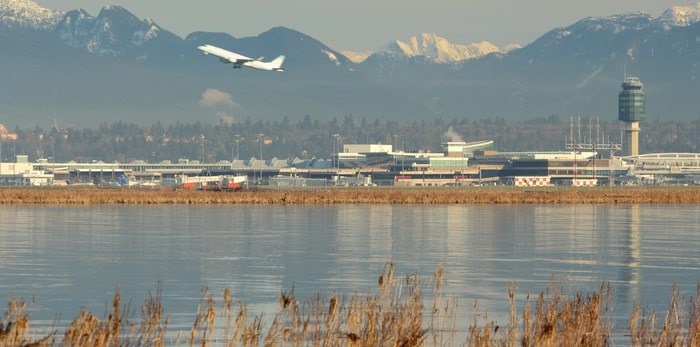The Canadian government should pass a law to cap the amount of money that the country’s airport authorities can charge in airport improvement fees (AIFs), Flair Air’s executive chairman David Tait told Business in Vancouver.
Tait’s airline in June 2018 converted to an ultra-low-cost carrier from being a charter airline, and it aims to keep base fares for passengers as low as possible.
 A flight takes off from YVR Airport near Vancouver/Shutterstock
A flight takes off from YVR Airport near Vancouver/Shutterstock
AIFs are among the fees that get folded into airfares and combine to help make Canadian airfares substantially more than counterparts in the U.S., he explained. The result of that disparity is that many B.C. travellers drive across the U.S. border to Bellingham in order to fly out of that airport and pay lower fees, he said.
While there are rare Canadian airports, such as Abbotsford International Airport, which do not have airport improvement fees, all of Canada’s main metropolitan airports charge improvement fees.
Tait’s data showed the following fees for out-of-province departures within Canada at airports at which Flair flies:
- Abbotsford International Airport: $0;
- Â鶹´«Ă˝Ół»International Airport: $20;
- Kelowna International Airport: $20;
- Toronto Pearson International Airport: $25;
- Winnipeg James Armstrong Richardson International Airport: $25;
- Halifax Stanfield International Airport: $28;
- Edmonton International Airport: $30; and
- Calgary International Airport: $30.
He then compared those rates to ones that are about half as steep in the U.S.
“The U.S. equivalent to AIFs is Passenger Facility Charges (PFCs), however these are federally limited to US$4.50 per segment, and can, if desired, be charged by both the point of departure and point of arrival airports for a maximum of US$9.00 per one-way segment – US$18 per round trip,” he said.
Airport executives in the U.S. have to report how they use their airport’s PFC funds, he said, adding that U.S. Federal Aviation Authority show that terminal building improvements account for 59.8% of the spending and 24.1% of the spending goes toward airside improvements, such as runway expansions. The rest largely goes to combat noise, improve road access.
Â鶹´«Ă˝Ół»Airport Authority corporate communications manager Brock Penner explained that Canadian airports operate differently than airports in the U.S.
“Â鶹´«Ă˝Ół»Airport Authority is a community-based, not-for-profit organization and we receive no money from the government to operate the airport,” he told BIV. “The AIF is an important part of the Canadian airport business model. It is collected to support capital infrastructure projects like runways and terminals to ensure we have a safe and efficient airport.”
Penner added that his airport has the lowest AIF of any major airport in Canada, at $5 for people travelling within B.C. and the Yukon, and $20 for passengers travelling outside of B.C.
“In 2018, the [Vancouver] Airport Authority collected $172.1 million in AIF revenue and invested $351.1 million in capital projects,” he said.
“We are in year two of our multi-billion dollar expansion program, which includes 75 projects over 20 years. We recently celebrated a major milestone with a steel-topping ceremony for the expansion of the airport's International Terminal Building, known as Pier D. The event marked the completion of the structural phase of the building, which remains on schedule to open in 2020.”


